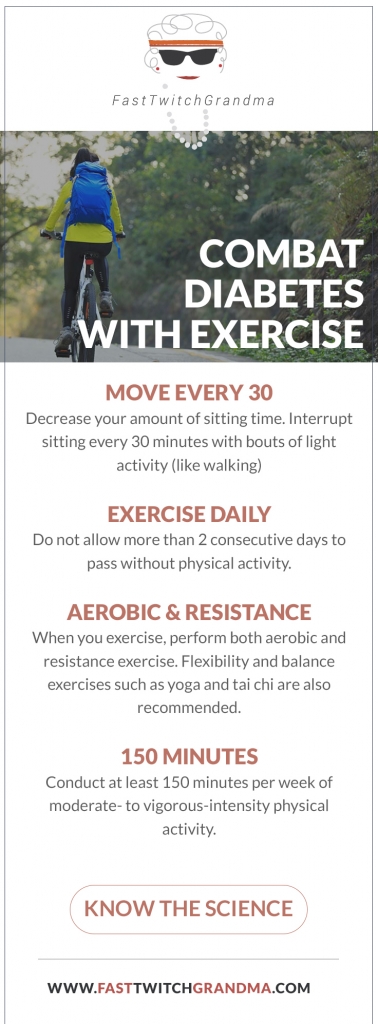Combat Diabetes With Exercise

Julia Basso – PhD
Did anyone enjoy some chocolate for Valentine’s Day?
 We all love sugar – we’re a society that loves sugar! Though the American Heart Association recommends that women consume no more than 25 grams (6 teaspoons) and men no more than 38 grams (9 teaspoons) of sugar per day, the average American consumes about 82 grams per day. This is certainly easy to do as drinking only one 12 ounce can of Coca Cola contains 39 grams of sugar.
We all love sugar – we’re a society that loves sugar! Though the American Heart Association recommends that women consume no more than 25 grams (6 teaspoons) and men no more than 38 grams (9 teaspoons) of sugar per day, the average American consumes about 82 grams per day. This is certainly easy to do as drinking only one 12 ounce can of Coca Cola contains 39 grams of sugar.
Sugar is, of course, important since the body uses glucose, or sugar, for energy. When we eat, food is broken down in the stomach and sugar enters the blood stream. The pancreas then secretes a hormone known as insulin. Insulin allows glucose to enter cells, which the cells then use as energy. Sometimes, however, this process goes awry.
What is Diabetes?
Diabetes is a disease where the body has difficulty regulating its glucose levels. Approximately 9.3% of the American population has diabetes, with approximately 1.4 millions cases diagnosed per year (American Diabetes Association). Diabetes is associated with and can lead to many other types of issues such as weight gain, high blood pressure, high cholesterol levels, sleep apnea, kidney disease, depression, sexual dysfunction, eye problems, and pain.
Related Article: Sugar – Is It Hurting Your Healthy Lifestyle
There are several different types of diabetes.
Type 1 diabetes is an autoimmune condition where the body attacks the pancreatic cells that produce insulin; this represents only 5-10% of all diabetic cases.
The other 90-95% of cases represent Type 2 diabetes, which results from a progressive loss of insulin secretion from the pancreas.
One type of diabetes, known as gestational diabetes mellitus, develops during pregnancy, but often dissipates after the baby is born.
Finally, pre-diabetes is a condition that is diagnosed when blood sugar levels are above the normal range but not high enough to be diagnosed as diabetes. These individuals are at a higher risk of developing Type 2 diabetes.
Health Benefits of Exercise
Exercise helps regulate blood glucose levels and has been shown to have considerable health benefits for patients with both Type 1 and 2 diabetes. Amazingly, exercise increases the amount of glucose that cells use by a factor of five. This enhanced glucose utilization can remain elevated for up to 48 hours after exercise, depending on the intensity of the exercise session.
Over the long-term, exercise helps to decrease the level of insulin resistance or enhance the ability of insulin to bring glucose into cells. The more you exercise, the better the outcome is. Fortunately, individuals with more severe cases of diabetes or pre-diabetes can show the biggest gains from exercise.
Related Article: Combat Heart Problems and Diabetes with HIIT
The Action Plan
“If I have diabetes, what types of exercise should I be doing?” you ask?
The American Diabetes Association has made several recommendations regarding exercising with diabetes, which I provide for you here.
Decrease your amount of sitting time. Interrupt sitting every 30 minutes with bouts of light activity (like walking)
Ideally, you should exercise daily. At minimum, do not allow more than 2 consecutive days (i.e., 48 hours) to pass without physical activity.
When you exercise, perform both aerobic and resistance exercise. Flexibility and balance exercises such as yoga and tai chi are also recommended.
Conduct at least 150 minutes per week of moderate- to vigorous-intensity physical activity.
Work towards a 5-7% reduction in total body weight, which can be accomplished both through exercise and healthy diet choices.
Things to Consider with Type 1 Diabetes
First, additional carbohydrate intake and/or insulin reductions before exercise may be required to maintain glycemic balance during or after exercise.
Second, continuous glucose monitoring during physical activity is recommended to prevent hypoglycemia (a drop in blood sugar).
Related Article: Sitting Disease – The New Smoking
Pregnancy and Diabetes
 Women who have preexisting diabetes should engage in regular physical activity prior to and during pregnancy. Additionally, if you are at risk for gestational diabetes mellitus, you should make sure to engage in 20 to 30 minutes of moderate-intensity exercise on most days of the week during your pregnancy.
Women who have preexisting diabetes should engage in regular physical activity prior to and during pregnancy. Additionally, if you are at risk for gestational diabetes mellitus, you should make sure to engage in 20 to 30 minutes of moderate-intensity exercise on most days of the week during your pregnancy.
Takeaway
Most importantly, if you have diabetes or pre-diabetes and would like to exercise, make sure to check with your doctor first to ensure that you are cleared to engage in physical activities. While you are there, ask for specific recommendations about what types of exercise are appropriate for you. This way, you can get the best exercise program to control your diabetic condition.
You Might Like:

















